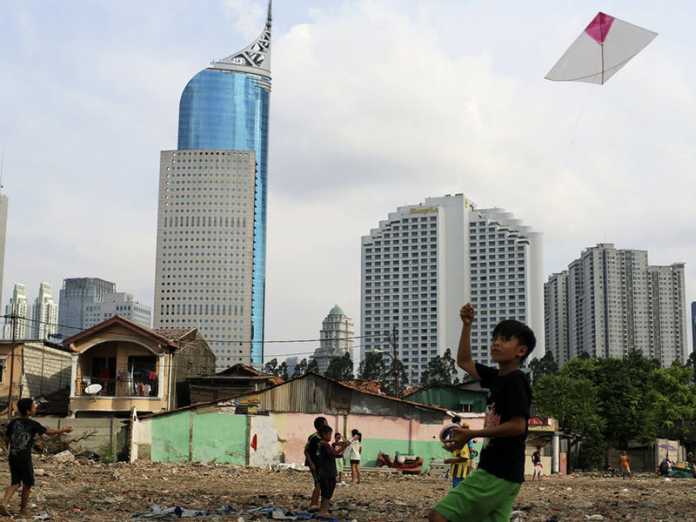
By Namira Samir
It is true that digital innovation helps ease problems of access to finance, reducing the literacy divide, among others. And we have heard enough of those tales. It has been in the spotlight for a long time, making us unaware of the beastly character of innovation that, instead of narrowing the gap between the rich and the poor, only promotes the concentration of wealth in just a few hands. By concentrating the analysis on Indonesia’s recent transition to an upper-middle-income country, this article shows how this achievement, which is measured by growth and was made possible by innovation, has not been able to address inequality.
Indonesia, much like other developing nations, is celebrating its upgrading to an upper-middle-income economy. Country-level income classifications rely on gross national income (GNI) per capita. Simply put, GNI is the gross domestic product (GDP) plus earnings from foreign sources. While an increase in GNI signifies an improvement in the overall welfare of a country, it does not necessarily mean that growth becomes equal.
Indonesia’s GNI per capita as of July 2020 is US$4,050[i], which means, on average, that is every Indonesian citizen’s income before tax. Now we know clearly that this is not the case. As of March 2020, 26.42 million Indonesians live on less than Rp454,652/month[ii]. If we convert that into USD, it is about US$370 per year. These people do not even own 10% of what has been widely celebrated as a new achievement of Indonesia.
There are two important questions to pose: how this happened and what should be done.
To answer the first question, let us start with a fact: as a developing country, Indonesia is in the process of catching up. Its upgrading to the upper-middle-income country was made possible because of two factors: demographic dividend and private consumption.
As mentioned in Thomas Piketty’s “Capital in the 21st Century”[iii], demographic dividend can be an equaliser, since it can further induce economic growth and eventually decrease inequality through reducing inherited wealth by the creation of new jobs and, understandably, the need for new skill sets.
Indonesia is a market economy, but it is also the tenth-biggest market in the world. The country is earning plenty from its demographic composition, which is dominated by those at the productive age – be it from contributing directly to the workforce or through private consumption.
As of June 2020, private consumption contributes 59.4% to Indonesia’s nominal GDP. While it is unrealistic to define Indonesia’s consumption-led growth solely from the 2020 figures, because of the economic contraction due to COVID-19 pushing Indonesia’s GDP into a negative term, if we take a look back at last year’s figure, Indonesia has already ridden consumption-led growth, in which consumption is higher than real GDP.
Constant growth, even as little as 0.5%, might address income inequality (Piketty, 2017). Meanwhile, Indonesia’s growth, while charmingly consistent at around 5% pre-COVID, seemed not to tackle income inequality. The Gini ratio of Indonesia wandered around at 39 to 41 – with no sign of any significant decline. Why?
From the poverty and inequality figures above, we can be confident that the income per capita of Indonesians is rising, but this is by and large only being felt by those who possess enormous private wealth, suit-and-tie workers, or those investing in an industry which witnesses a surge in demand, such as the digital industry.
However, in the process of catching up, the government should have paid attention to using growth as an equaliser by investing in public assets that seek to reduce income inequality and, hence, poverty.
The Indonesian government is gradually increasing public assets in health, education and even housing. Yet, the tale of poverty as a problem of basic needs is ancient. Likewise, the solution to addressing income inequality is not by excessive taxation on the rich and distributing the money to the rest of the population. Something is different in the 21st century.
Innovation and Inequality
Redistribution of wealth will occur when we address the root causes of inequality. Innovation, while it scales up GNI per capita, might sustain, or even worsen, inequality.
To put this into context, let us consider technological innovation in an entertainment company that we are all familiar with: Netflix. A monthly Netflix subscription in Indonesia would cost roughly US$7.39 (Rp100,000) per month. For you to be able to watch Netflix in the first place, you need an internet connection – and an electronic device, obviously.
Some domestic players are also attempting to offer domestic-level entertainment with a competitive price range. People are attracted to this lifestyle, because it offers comfort and flexibility. You no longer need a TV to watch a movie or to keep up to date with current affairs. But at what cost?
Not only has the source of entertainment switched to an extremely virtual medium, but access to information, too, and buying access to information from reliable channels might influence social mobility. So, it is imperative to ask who can access these sources and who gains from this innovation. Whose wallets are shrinking and whose bank accounts are loaded with cash? As of now, innovation encourages growth but perpetuates inequality.
But that does not mean all innovations produce unfavourable outcomes for reducing inequality. A number of digital companies are working to spread awareness of Indonesia’s development issues. Asumsi.co’s #KerahBiru is an example of digital content which aims to narrate the story of manual labourers, who hardly benefit from the rising GNI per capita. Since they cannot benefit directly from innovation, then having an intermediary can ease the process of social mobility. Although #KerahBiru might have no direct effect on reducing inequality, it sets an example of using innovation to articulate the story of – instead of accumulating growth.
The story of innovation has been primarily focused on the digitalisation of financial services and economic activities which are documented to contribute to inclusive development. It is a good narrative, albeit built on an ugly reality. By continuing to retell the success stories of innovation, our insights are blinded from seeing what innovation has brought and how we should respond so as to prevent the intensification of precarity.
It is hard to know what will work against inequality in the 21st century, because we are dealing with a fast-changing world that will continue to twist us with unpredictable eventualities. Innovation is inevitable. But when it preserves the imbalance of wealth, the state must interfere. The government needs to recognise the presence of different powers that dominate national-level earnings. As a starter, the government might start incorporating innovation-related resources that can factor development into the definition of public assets.
Once again, our duty is not just to raise pity. Neither is it merely about showing empathy. Rather, it is about making sure that one day, GNI per capita, just like any other growth measure, can at least loosely reflect the welfare of citizens – not only as a collective but as individuals.
About the Author
Namira Samir is a PhD candidate at The London School of Economics and Political Science (LSE). As a development economist, she uses an interdisciplinary approach and mixed methods to understand poverty and inequalities. Her PhD research focuses on the development geography of Islamic Microfinance in Indonesia.
Reference
[i] https://blogs.worldbank.org/opendata/new-world-bank-country-classifications-income-level-2020-2021
[ii] https://www.thejakartapost.com/news/2020/07/15/poverty-rate-rises-in-march-as-pandemic-hits-vulnerable-communities.html
[iii] http://piketty.pse.ens.fr/en/capital21c2




































































